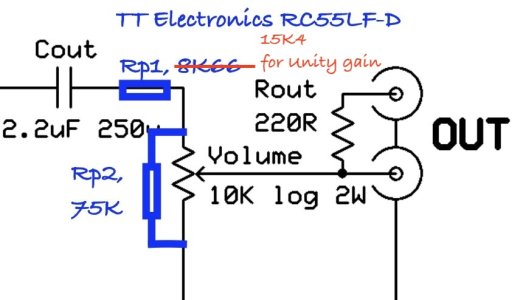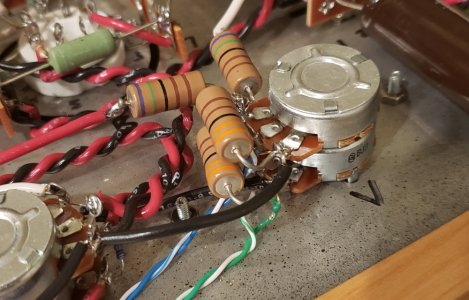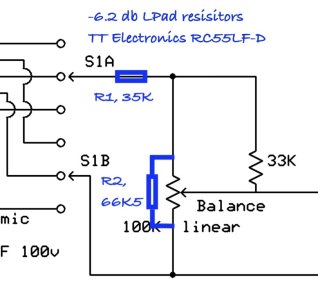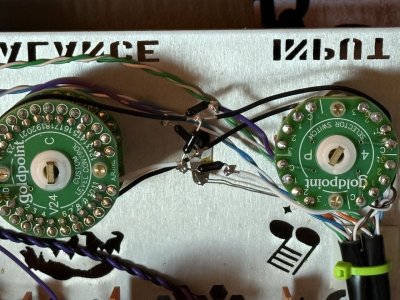Alan, The two resistors are the Lpad (that term just is the name for connecting resistors to a signal input in that configuration) and yes, they are the only thing you need. You will connect them to the volume pot that comes with the kit. Note that you need two of each resistor, one for the left channel and one for the right channel. The kit doesn't include an Lpad.
Congrats on that choice, I'm sure you will enjoy both the process of building it and listening! And you will be amazed by the incredible value it represents.
One pretty good site to learn about tube tech is The Valve Wizard and this page is a good place to start: http://www.valvewizard.co.uk/gainstage.html. The author is British so some of the terminology differers from American terms.
The Moreplay, and most Bottlehead circuits are triode based and the majority are of the type known as common-cathode, which means the cathode is connected the ground circuit, usually with a low value resistor (hundreds of ohms) that sets it's bias. Bottlehead designs are not simple triode circuits though. They include several sophisticated and in some cases unique circuit designs that set apart their circuits in ways that contribute both their ease of construction, but more importantly, their superior performance.
Here's a bit of terminology can get you started on understanding the material, forgive me if you already know all this, but if you don't, it will really help comprehending the information at the beginning.
Valve - Britt's term for tube.
Common - refers to the ground circuit and basically means grounded. It comes from the fact that all parts of the circuit that a grounded are connected to the same "common" ground. By convention it is zero volts in the circuit and all other voltages are defined in reference to the ground being zero volts. You may also see a term "referenced to ground" which means either connected directly to ground with a wire, or with a resistor. Using a resistor will introduce a voltage offset if current flows (see Ohm's Law below).
Triode - A tube with three connections, Cathode, Grid, and Plate or Anode
- The Cathode is heated to allow it to freely emit electrons.The cathode is held at a low slightly positive voltage typically
- The Plate is held at a high positive voltage and will attract electrons from the cathode
- The Grid is an open mesh electrode between the cathode and plate. By being placed so it's voltage is what the cathode experiences rather that the plate voltage, which the cathode would experience if there were no grid. The grid's voltage is modulated by the audio signal. By doing so it reduces electron flow from the cathode when the voltage dips and increases electron flow when the voltage rises. This causes a modulated current to flow to the plate, and that current passes through a load resistor producing a much larger voltage audio output signal (again see Ohm's Law below to understand the idea of a resistor converting current to voltage).
Bias - refers to setting the zero signal voltage relationships between the cathode, grid and plate. This is a design parameter that sets a tube to operate in a range of voltages suitable for the circuit's function. In the simplest case, bias is set with resistors connected either to ground or the B+ voltage, also called rail voltage or "rails".
B+ - refers to the high positive voltage that's provided by the amplifier power supply. Ideally it will remain a a fixed positive voltage typically in the 150 - 600 VDC range for tube amplifiers, the specific value depends on the operating needs of the tube type used. How well the power supply is designed will have a huge influence on how stable that voltage is under varying load and how free it is of AC ripple and noise. Any variation in B+ will result in unwanted modulation in the output audio signal, which is why power supply design is so critical. BTW, Britts call B+ "HT", short for High Tension. Tension is an old-timey British term for voltage.
Ohm's Law - This is super useful in understanding resistors:
V = I X R, Voltage = Current times Resistance. The units are volts, amps, and ohms. This equation can be used to calculate bias voltages etc.
The Power Law - This allows you to calculate power if you know the voltage and current:
P = V X I, Power is equal to Voltage times Current. The units are Watts, Volts and Amps.
Combining Ohms's Law and the Power Law allows calculating all kinds of useful things, like power dissipation in wire or resistors, speaker power output, and amp loads etc. One common way to use the combined equations is to substitute for voltage in the Power Law from Ohm's law, which gives this equation:
- P = I^2 X R This can tell you how much power is dissipated by wire or a resistor or a speaker if a constant current source is connected to it. If you substitue for current instead you get this equation.
- P = V^2/R This can tell you power is dissipated if a constant voltage source is connected.
These are the most important equations for understanding what electrical circuits are doing, and as you can see, they are surprisingly simple. But it's quite amazing how deeply your insight can be by learning how to apply them.




